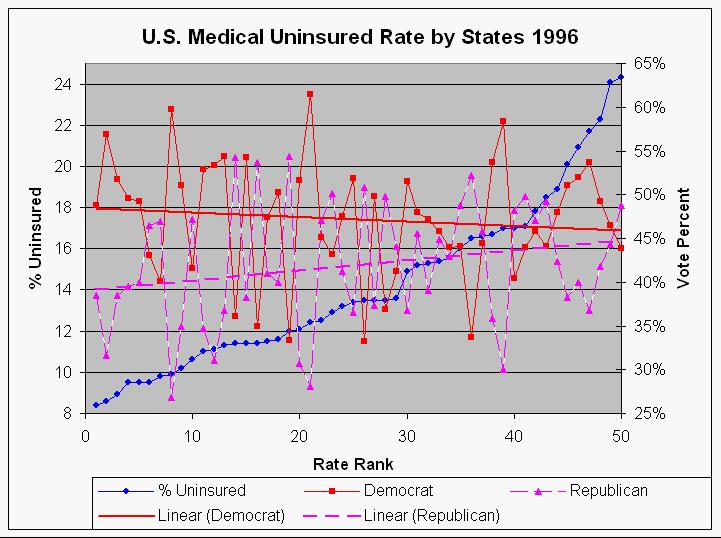
(Back to
Politics)
(Back to United States Health and
Political Parties)
(Go to data table at
bottom.)
The medical-uninsured rate (number/1000) varies greatly among the states in the United States. (See table at end for 1996 rates.)
An interesting question to ask is: Is there any correlation between the medical-uninsured rate and the strength of the two political parties in the states?
I compared different state's medical-uninsured rate (MUR) data for 1996 with the results of the 1996 presidential election for each state. (See table at end for votes in the 1996 election.) A correlation calculation yielded the following:
| Correlation | Rate |
| Democrat vote | -0.052 |
| Republican vote | +0.194 |
That is, the Democratic votes for the states had a 5% negative correlation with increasing MUR and the Republican votes had a 19% positive correlation. States with high medical-uninsured rate vote more Democratic than Republican and vice versa.
 |
| This is a plot of the medical-uninsured rate (MUR) sorted by rank of the states compared to the Democratic votes and the Republican votes. (See table at end for the data.) Also shown are linear fits to the two votes. This shows visually the negative correlation of MUR with the Democratic vote and the positive correlation with the Republican vote. Note the huge difference between the highest state (Texas with 24.3 and the lowest state (Wisconsin with 8.4). |
What can one conclude from these results? Whatever factors cause the large disparity for medical-uninsured rates between the various states also cause those states to tend to vote Republican.
My Republican native state, Oklahoma (rate=17), ranked 40 of 50 and my Republican adopted state, Virginia (rate=12.5), ranked 22 of 50 for increasing medical-uninsured rate in 1996.
| U.S. medical uninsured | 1996 election | |||
| State | % Uninsured | Democrat | Republican | Rank |
| Wisconsin | 8.4 | 48.8% | 38.5% | 1 |
| Hawaii | 8.6 | 56.9% | 31.6% | 2 |
| Michigan | 8.9 | 51.7% | 38.5% | 3 |
| New Hampshire | 9.5 | 49.6% | 39.6% | 4 |
| Pennsylvania | 9.5 | 49.2% | 40.0% | 5 |
| South Dakota | 9.5 | 43.0% | 46.5% | 6 |
| North Dakota | 9.8 | 40.1% | 46.9% | 7 |
| Rhode Island | 9.9 | 59.7% | 26.8% | 8 |
| Minnesota | 10.2 | 51.1% | 35.0% | 9 |
| Indiana | 10.6 | 41.6% | 47.1% | 10 |
| Connecticut | 11 | 52.8% | 34.7% | 11 |
| Vermont | 11.1 | 53.4% | 31.1% | 12 |
| Illinois | 11.3 | 54.3% | 36.8% | 13 |
| Kansas | 11.4 | 36.1% | 54.3% | 14 |
| Maryland | 11.4 | 54.3% | 38.3% | 15 |
| Nebraska | 11.4 | 35.0% | 53.7% | 16 |
| Ohio | 11.5 | 47.4% | 41.0% | 17 |
| Iowa | 11.6 | 50.3% | 39.9% | 18 |
| Utah | 12 | 33.3% | 54.4% | 19 |
| Maine | 12.1 | 51.6% | 30.8% | 20 |
| Massachusetts | 12.4 | 61.5% | 28.1% | 21 |
| Virginia | 12.5 | 45.1% | 47.1% | 22 |
| Alabama | 12.9 | 43.2% | 50.1% | 23 |
| Missouri | 13.2 | 47.5% | 41.2% | 24 |
| Delaware | 13.4 | 51.8% | 36.6% | 25 |
| Alaska | 13.5 | 33.3% | 50.8% | 26 |
| Washington | 13.5 | 49.8% | 37.3% | 27 |
| Wyoming | 13.5 | 36.8% | 49.8% | 28 |
| Montana | 13.6 | 41.3% | 44.1% | 29 |
| West Virginia | 14.9 | 51.5% | 36.8% | 30 |
| Tennessee | 15.2 | 48.0% | 45.6% | 31 |
| Oregon | 15.3 | 47.2% | 39.1% | 32 |
| Kentucky | 15.4 | 45.8% | 44.9% | 33 |
| Nevada | 15.6 | 43.9% | 42.9% | 34 |
| North Carolina | 16 | 44.0% | 48.7% | 35 |
| Idaho | 16.5 | 33.6% | 52.2% | 36 |
| Colorado | 16.6 | 44.4% | 45.8% | 37 |
| New Jersey | 16.7 | 53.7% | 35.9% | 38 |
| New York | 17 | 58.3% | 30.0% | 39 |
| Oklahoma | 17 | 40.4% | 48.3% | 40 |
| South Carolina | 17.1 | 44.0% | 49.8% | 41 |
| Georgia | 17.8 | 45.8% | 47.0% | 42 |
| Mississippi | 18.5 | 44.1% | 49.2% | 43 |
| Florida | 18.9 | 48.0% | 42.3% | 44 |
| California | 20.1 | 51.1% | 38.2% | 45 |
| Louisiana | 20.9 | 52.0% | 39.9% | 46 |
| Arkansas | 21.7 | 53.7% | 36.8% | 47 |
| New Mexico | 22.3 | 49.2% | 41.9% | 48 |
| Arizona | 24.1 | 46.5% | 44.3% | 49 |
| Texas | 24.3 | 43.8% | 48.8% | 50 |
(Back to top of data
table)
(Back to the top of this page)
(Back to United States Health and Political
Parties)
(Back to Politics)